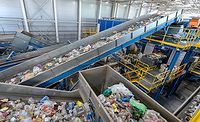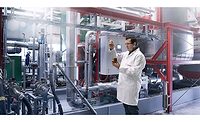Recycling Must Evolve: The Key to Tackling Packaging Waste
Better recycling programs and government and academic partnerships can help address the problem of plastic packaging waste in the U.S.

Images courtesy of piotr_malczyk via www.gettyimages.com.
The United States needs to do a much better job at recycling. This is especially true for plastics waste, which at a 5% recycling rate is trailing recycling rates for other packaging and containers: glass (40%), aluminum beverage cans (45%), paper (63%), steel food cans (68%), and corrugated (91%). What will it take to boost recycling rates and achieve the Environmental Protection Agency’s goal of a 50% recycling rate by 2030? Action is needed in many areas, but harmonization and regularization of recycling rules and programs is crucial.
Steps for Better Recycling Programs
To start, the United States needs improved data collection, because what’s not measured can’t be managed. “Stronger data is the necessary first step toward modernizing American recycling infrastructure, strengthening U.S. community recycling programs by determining needs, providing education and access, and ultimately capturing valuable materials for the circular economy,” said Dylan de Thomas, vice president of External Affairs at The Recycling Partnership.
Along with more data, regularization of what can and can’t be recycled will make the process easier for consumers, thereby driving more material into recycling streams. For example, uniform collection standards can eliminate the variability of what is collected across programs and the confusion consumers experience when one program or municipality collects a material such as polypropylene (PP) or glass and neighboring programs do not. At the same time, clearer labeling of disposal information is important so that consumers know how and where to recycle an empty package. This also minimizes contamination, which can reduce the quality of the recyclate or even render it unusable.
Current Efforts Making a Difference
Many organizations are taking action to eliminate barriers to recycling. As part of its “Blueprint for America’s Recycling System,” the Recycling Leadership Council (RLC), a group convened in 2020 by the Consumer Brands Association, calls for a national strategy on recycling and policy action, including a plan to standardize the recycling system.
“Besides … the obvious benefits of a single set of rules to limit consumer confusion, a standardized system across the United States would create scale and efficiency,” explained Meghan Stasz, senior director, Sustainability, at the Consumer Brands Association, in a recent blog post. She added, “Currently, each program collects different combinations of materials. With a standardized system, programs can collect more volume, which allows for more and different types of materials to be collected and processed for post-consumer recycled content, keeping recyclable waste out of landfills and waterways.”
The American Beverage Association is also undertaking efforts to spur more recycling. The goals of its Every Bottle Back program are to improve recycling infrastructure, measure the industry’s plastic footprint, make 100% recyclable bottles, add recycling-promoting messaging on packaging, raise awareness, and inspire action. Similarly, the Can Manufacturers Institute is working to retrieve the 25% of aluminum cans currently missorted and lost at material recovery facilities. Toward that end, it has established a grant program to help install eddy current equipment and quality-control robots that can identify and capture the cans that otherwise would be overlooked.
Recycling technology is evolving too. To maximize the yield of post-consumer recycled plastics, The Wolfson Centre for Materials Processing, Brunel University London, developed PRISM (Plastic Packaging Recycling using Intelligent Separation technologies). Now known as polyPRISM, the technology invisibly tags plastic containers for sorting into food-grade and non-food-grade streams for recycling. Coded mixtures of invisible phosphor inks are applied to labels and identify the plastic regardless of color as well as the contents of the container. To sort the marked containers, recyclers only need to add a low-cost ultraviolet light source to their near-infrared sorting systems, which can be programmed to read the phosphor codes.
A multi-client project called NEXTLOOPP, led by Nextek, a consultancy specializing in the design, optimization, processing, and recycling of plastic materials, is developing polyPRISM technology to sort and wash PP containers to establish closed-loop recycling for food-grade PP. Separation rates exceeded 99% in full-scale trials. Next steps include a commercial-scale test and food-grade accreditation. Consumer packaged goods companies (CPGs) that are members of NEXTLOOPP and that wish to adopt polyPRISM coding technology may have packaging evaluated and labels printed to the required standard. Eventually, procedures will be established to broaden access to the technology. Recyclers may license the polyPRISM technology from NEXTLOOPP.
Government and Academic Partners Play a Role
CPGs must commit to using recycled content to develop a circular economy, but better sorting technologies, cutting-edge materials science, and a collaborative approach with all stakeholders is necessary to address the scale of the plastics waste issue.
At the federal level, the U.S. Department of Energy is funding seven research and development projects to convert plastic films into more valuable materials and design new plastics that are more recyclable and biodegradable. “Single-use plastics generate large amounts of carbon pollution when produced, are hard to recycle, and dirty our nation’s beaches, parks, and neighborhoods,” said Secretary of Energy Jennifer M. Granholm. Three projects are of particular interest to packagers. Michigan State University will create a redesign for inherently recyclable plastics. The University of Massachusetts – Lowell will integrate delamination and carbonization processes for the upcycling of single-use, multilayer plastic films, and West Virginia University Research Corp. will develop process-intensified modular upcycling of plastic films to monomers by microwave catalysis.
Lastly, educating consumers can’t be forgotten. CPGs are helping consumers recycle correctly by adopting the How2Recycle label, which provides information about local recycling programs. Established in 2012 by the Sustainable Packaging Coalition, the program seeks to standardize recycling labeling, divert recyclables from landfills, and teach consumers more about recycling.
To make a real difference in recycling rates and tackle the persistent problem of plastic waste, it will take commercial, governmental, and academic partners working together along with end users and consumers. Fortunately, with so many stakeholders focused on improving recycling, progress is being made and this momentum can be continued going forward.
Learn more about PMMI at pmmi.org.
Looking for a reprint of this article?
From high-res PDFs to custom plaques, order your copy today!





